CLM Mobile App has been enhanced by the Mobile Payments functionality
- Published
- 4 min reading

Mobile Payments functionality allows users to store there their favorite form of payment and use it during the in-store journey or when they would like to pay for fuel directly at the pump. It's not easy to draw any positives from the COVID-19 pandemic. Nevertheless, one of the universal features of the global response is the desire of customers to use contactless payment methods wherever possible.
That’s why fuel retailers need to be able to accept mobile payments as part of their transformation. Mobile payments can reduce the time needed to activate a pump, and they allow customers to pay directly from an app without the need to enter the store. The emergence of COVID-19 means that mobile payments are going to be adopted faster than planned at most fuel stations. This is especially evident at the mature end of the market, where stations already offering mobile payments saw a two-fold lower decrease in sales during the pandemic compared to those fuel retailers without mobile payment facilites. In other words, B2C the popularity of payment applications is increasing significantly among end customers.
There are different types of mobile payments at fuel stations. Three use cases need to be taken into consideration by fuel retailers when thinking about implementing mobile payments at their forecourts: pre-paid for fuel, post-paid for fuel, and pre-ordering for non-fuel products. In prepaid scenarios, customers pay up front (funds are blocked in their app wallet from the very beginning). In other words, when a customer is selecting their fuel and method of payment (MoP), funds are instantly blocked. In postpaid scenarios, customers pay after refueling based on how much fuel they purchase. Ordering non-fuel products is very similar to the pre-paid scenario, but is more advance – involving processes such as stock management and order management.
Pre-paid scenario
The major element that distinguishes pre-paid mobile payments from post-paid models is the fact that each transaction/basket is created in a mobile application. A customer generates the transaction by choosing fuel type and method of payment directly from the mobile application before refueling. The transaction is not created at the pump (as it is in post-paid model).
The funds are immediately blocked in the customer’s account. This allows retailers to protect themselves against fuel theft, and is treated as an additional security measure to stop fuel fraud. There is also another security method available in the pre-paid process, connected with the number of liters pumped (verifying whether the declared amount of fuel pumped is the same as the actual amount).
| PROS | CONS |
| Additional security measures for fuel dealers to avoid fuel theft (blocking funds and checking amounts of fuel) | More advanced (compared to post-paid) |
| Higher level of safety for customers (no interaction with the pump) | No option for up-sell or cross-sell |
| Recommended for: stations with no stores | |
| Required investment: $$ | |
Post-paid scenario
Simple, fast and transparent – those are the words that describe this model very well from different perspectives. The post-paid scenario is tailored for fuel retailers who want to introduce mobile payments relatively quickly compared to other models. What’s more, it is perfect for all companies that want to innovate quickly at relatively low cost. It is much simpler to implement than pre-paid, with no checks on fuel volume or blocked funds. It is similar from the customer experience perspective. There is no need to choose a pump or type of fuel before refueling. The customer simply stops at the pump, refuels, and then begins interaction with the mobile application. All they need to do is select the pump number (QR codes or beacons can also be used) and pay. This model is also well suited for fuel stations looking for solutions to speed up the payment process on their forecourts, especially in situations with traffic jams during rush hour (for example, early mornings when people are going to work) or in specific seasons (such as summer, when people travel a lot).
| PROS | CONS |
| Simple, fast and transparent for customers (fuel, pay and go) | No option for up-sell or cross-sell |
| The easiest model to implement | |
| Higher level of safety for customers (no interaction with the pump) | |
| Recommended for: stations with no stores but high traffic | |
| Required investments: $ | |
When thinking about implementing any kind of mobile payment system, it is very important to consider the nature of the market. In the upcoming article, pre-ordering for non-fuel products will be covered. Subscribe to our newsletter or contact us for more information.


